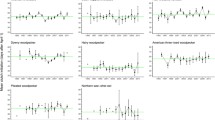Abstract
We examined the relationships between cavity temperature, ambient temperature outside the cavity and structural characteristics of 70 cavities measured for 1 night to determine if cavity roosting birds may potentially select warmer tree cavities for wintertime roosting. The mean temperature increment of the cavity (=cavity-ambient temperature) varied from −2.4 to 4.9°C and increased with higher day-to-night fluctuations in the ambient temperature, smaller cavity entrance and better health status of the cavity tree. Cavities in healthy trees were warmer than those in dead trees, but this difference disappeared with rising mean ambient temperatures. This interaction between the effects of tree health status and mean ambient temperature, as well as the effect of day-to-night fluctuations in the ambient temperature, were supported by the analysis of repeated measurements of temperature taken on 12 consecutive nights in five cavities. The variability in cavity microclimates makes the selection of warmer roost sites possible, and the predictors of microclimate may provide indirect cues to prospecting birds.

Similar content being viewed by others
References
Busse P, Olech B (1968) On some problems of birds spending nights in nestboxes. Acta Ornithol 11:1–26
Buttemer WA (1985) Energy relations of winter roost-site utilization by American goldfinches (Carduelis tristis). Oecologia 68:126–132
Christe P, Oppliger A, Richner H (1994) Ectoparasite affects choice and use of roost sites in the great tit, Parus major. Anim Behav 47:895–898
Cooper SJ (1999) The thermal and energetic significance of cavity roosting in mountain chickadees and juniper titmice. Condor 101:863–866
Derby RW, Gates DM (1966) The temperature of tree trunks-calculated and observed. Am J Bot 53:580–587
Du Plessis MA, Williams JB (1994) Communal roosting in green woodhoopoes: consequences for energy expenditure and the seasonal pattern of mortality. Auk 111:292–299
Du Plessis MA, Weathers WW, Koenig WD (1994) Energetic benefits of communal roosting by acorn woodpeckers during the nonbreeding season. Condor 96:631–637
Havera SP (1979) Temperature variation in a fox squirrel nest box. J Wildl Manage 43:251–253
Hooge PN, Stanback MT, Koenig WD (1999) Nest-site selection in the acorn woodpecker. Auk 116:45–54
Kempenaers B, Dhondt AA (1991) Competition between blue and great tit for roosting sites in winter: an aviary experiment. Orn Scand 22:73–75
Kendeigh SC (1961) Energy of birds conserved by roosting in cavities. Wilson Bull 73:140–147
Ligon JD, Carey C, Ligon SH (1988) Cavity roosting, philopatry, and cooperative breeding in the green woodhoopoe may reflect a physiological trait. Auk 105:123–127
Mayer L, Lustick S, Battersby B (1982) The importance of cavity roosting and hypothermia to the energy balance of the winter acclimatized Carolina chickadee. Int J Biometeorol 26:231–238
Mazgajski TD (1998) Nest-site characteristic of great spotted woodpecker Dendrocopos major in central Poland. Pol J Ecol 46:33–41
Mazgajski TD (2002) Does the great spotted woodpecker Dendrocopos major select holes for roosting? Pol J Ecol 50:99–103
McComb WC, Nobble RE (1981) Microclimates of nest boxes and natural cavities in bottomland hardwoods. J Wildl Manage 45:284–289
Moore AD (1945) Winter night habits of birds. Wilson Bull 57:253–260
Nicolai V (1986) The bark of trees: thermal properties, microclimate and fauna. Oecologia 69:148–160
Reinertsen RE, Haftorn S (1986) Different metabolic strategies of northern birds for nocturnal survival. J Comp Physiol B 156:655–663
SAS Institute (2005) SAS OnLine Doc. SAS Institute, Cary, NC
Sedgeley JA (2001) Quality of cavity microclimate as a factor influencing selection of maternity roosts by a tree-dwelling bat, Chalinolobus tuberculatus, in New Zealand. J Appl Ecol 38:425–438
Stains HJ (1961) Comparison of temperatures inside and outside two tree dens used by racoons. Ecology 42:410–413
Walsberg GE (1986) Thermal consequences of roost-site selection: the relative importance of three modes of heat conservation. Auk 103:1–7
Webb DR, Rogers CM (1988) Nocturnal energy expenditure of dark-eyed juncos roosting in Indiana during winter. Condor 90:107–112
Wiebe KL (2001) Microclimate of tree cavity nests: is it important for reproductive success in northern flickers? Auk 118:412–421
Acknowledgements
This study was supported by the Ministry of Education of the Czech Republic (grant no. MSM 6198959212). We thank also P. Adamik, P. Rawsthorne and referees for helpful comments on the manuscript.
Author information
Authors and Affiliations
Corresponding author
Rights and permissions
About this article
Cite this article
Paclík, M., Weidinger, K. Microclimate of tree cavities during winter nights—implications for roost site selection in birds. Int J Biometeorol 51, 287–293 (2007). https://doi.org/10.1007/s00484-006-0067-2
Received:
Revised:
Accepted:
Published:
Issue Date:
DOI: https://doi.org/10.1007/s00484-006-0067-2




